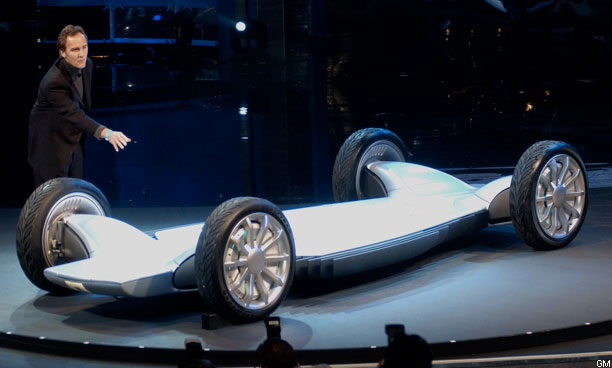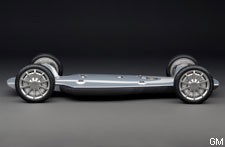
Unveiled at the 2002 Detroit auto show, it was supposed to be GM's radical vision for a truly futuristic car. Freed from the tyranny of the internal combustion engine, GM was going to revamp the entire automotive paradigm with this, it's most audacious concept car ever. Behold, the billion-dollar Skateboard! GM actually called it "Autonomy," even using nonsensical capitalization to help the dim-witted understand that the first four letters of autonomy spell "auto." That billion-dollar number was thrown around to convince people that GM was serious about making some sort of play in the green vehicle space – which, if you'll remember – didn't actually exist in January 2002, nearly two years before the second-generation Toyota Prius ignited the category. GM had been showing plenty of fuel cell technology at the time, including stationary fuel cells that could be used to power homes and fuel cells for commercial applications, like providing back-up power to cell phone towers, so the whole notion was nearly as believable as it was far-fetched.
 The idea was that GM would create this standard "autonomous" platform, using a compact hydrogen fuel cell for power and electric drive motors mounted in the wheels, and then just attach any number of different lightweight bodies to it. All the steering and braking would be accomplished through "drive-by-wire" electronic controls, and everything could be packaged within in the six-inch-thick floor, such that the skateboard would operate completely independently. If this sounds a lot like a body-on-frame rolling chassis from the pre-war era of automotive manufacture, well, you've got the right idea.
The idea was that GM would create this standard "autonomous" platform, using a compact hydrogen fuel cell for power and electric drive motors mounted in the wheels, and then just attach any number of different lightweight bodies to it. All the steering and braking would be accomplished through "drive-by-wire" electronic controls, and everything could be packaged within in the six-inch-thick floor, such that the skateboard would operate completely independently. If this sounds a lot like a body-on-frame rolling chassis from the pre-war era of automotive manufacture, well, you've got the right idea.
There were plenty of reasons to like the Autonomy, especially when GM started talking about how power could be increased just by swapping in a larger fuel cell stack, or how owners could conceivably switch body shells to turn the car from a sporty coupe into a roomier sedan. That the "car" was free from mechanical systems meant that ostensibly its handling attributes could be programmed in software and changed on the fly. Designers would have a field day it seemed, without such old fashioned restraints like an engine bay to intrude upon the cockpit or an exhaust system that needed to run underneath the length of the car. From a manufacturing perspective, the Autonomy would have revolutionized the industry, as its modular systems approach and unconventional design would have rendered many traditional auto plants unnecessary. We're sure there were bean counters throughout the industry salivating at the notion of being able to close down transmission and engine plants across the globe.
Autonomy made big headlines, especially when a drivable concept car, the Hy-wire, was unveiled later in the year, just after GM opened a fuel cell development center in New York state. GM promised to have a car based on Autonomy on sale by 2010, and one of its chief designers on the project boasted to a reporter from Business 2.0 magazine, "We've changed the world."
Except that eight years later, the company actually seems much further from producing anything even remotely like the Autonomy than it did then. We'll not turn this into another rehash of events leading to GM's bankruptcy, as Autonomy had disappeared from the limelight long before GM's implosion, replaced by the Chevy Volt. The Volt is a fairly conventional car, albeit one with a somewhat unconventional drivetrain. With its front-mounted internal combustion engine and an electric front-wheel-drive transaxle based on GM's two-mode hybrid design, the Volt may be different from any other car on the market, but it couldn't be further from Autonomy in conception or execution.
While GM and the rest of the auto industry continue to develop fuel cell technology, it's clear that we aren't going to see anything resembling the Autonomy any time soon.


Sign in to post
Please sign in to leave a comment.
Continue